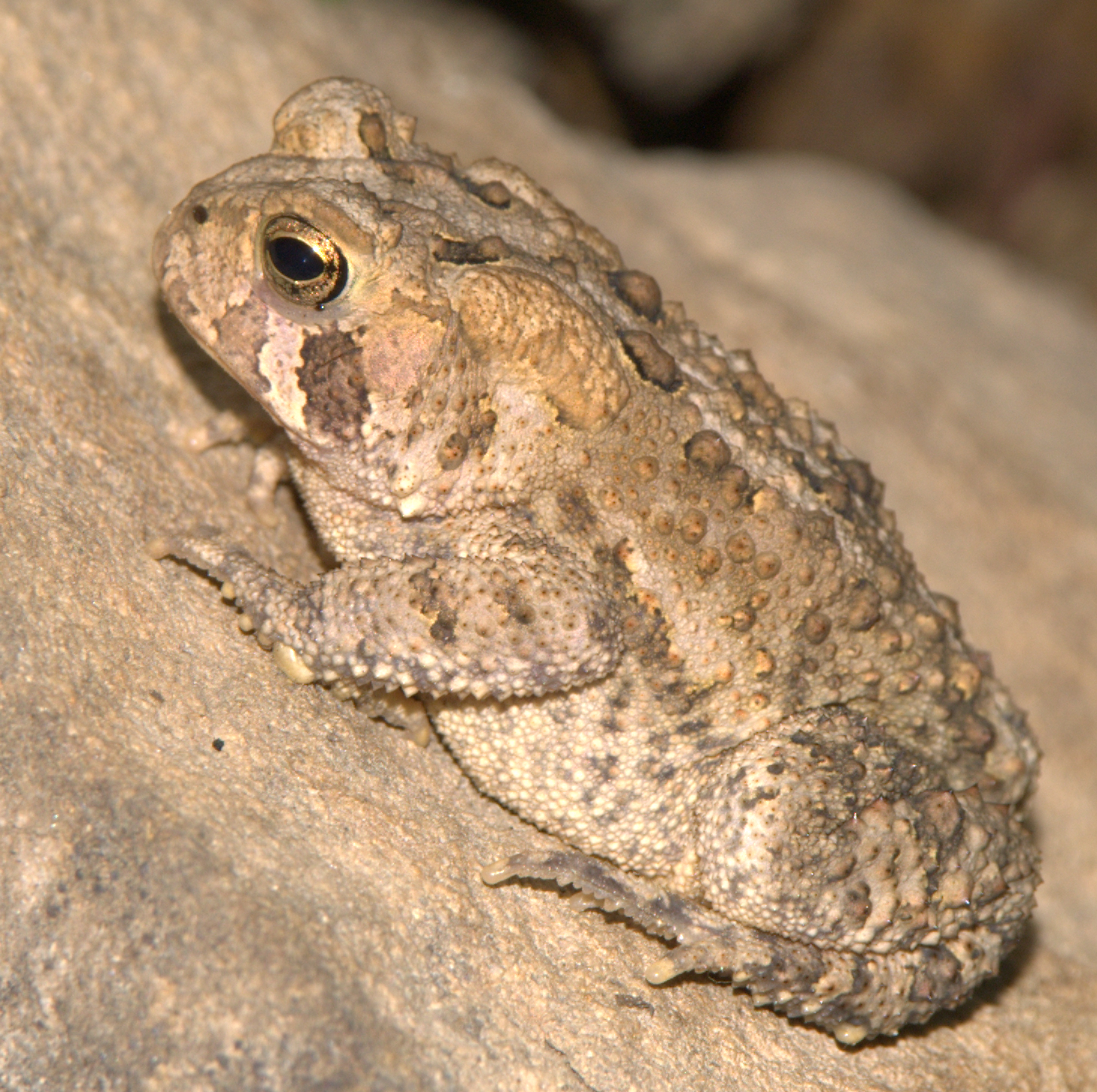- Bufo fowleri
Taxobox
name = Fowler's Toad

imagesize = 235px
status = LC
status_system = iucn3.1
regnum =Animalia
phylum =Chordata
classis =Amphibia
ordo =Anura
familia =Bufonidae
genus = "Bufo "
species = "B. fowleri"
binomial = "Bufo fowleri"
binomial_authority = Hinckley, 1882
synonyms = "Anaxyrus fowleri"
(Hinckley, 1882)Fowler's Toad ("Bufo fowleri") is a species of
toad in theBufonidae family.Physical Description
Fowler's toads are usually brown, gray, or olive green in color and have black edged dark spots on its back, with a light middorsal stripe. In each of the dark spots there are found to be three or more
wart s. The ventral surface (belly) is usually whitish and almost completely unspotted. "Bufo fowleri" is noted for having a single dark spot on its otherwise spotless belly. Males are often found to be darker in color while females are found to be lighter. Its body measures between 5 to 9.5 centimeters in length. Fowler's toadtadpole s have a short oval body and a long tail with an upper and lower fin. Their size is 1 to 1.4 centimeters long (Wright, 1949; Collins, 1991).Reproduction
"B. fowleri" is known to reproduce in warmer seasons of the year, usually between the months of
May andJune . Breeding sites are located in shallow waters that are very open, including farmpond s,lake edges,marsh es, and woodland ponds. Breeding habits of "B. fowleri" are very similar to "Bufo americanus ". The male will migrate to the breeding sites where he will begin calling his mate in intervals that can last up to thirty seconds. The call often attracts both male and females which will cause mistaken identities in the breeding process. This mistake occurs when one male tries to mate with another male. Fortunately, the first male will realize the mistake, because the other male will let out a chirpingrelease call that informs the male of his mistake. When the male finally meets his mate, the male will try to clasp the female from behind (calledamplexus ). From this position the male can fertilize up to 7,000-10,000 eggs. Fertilization is external. The eggs are known to hatch in two to seven days. The tadpoles will begin to undergo the change into tiny toads thirty to forty days later. In one growing season, "Bufo fowleri" may grow to sexual maturity, but slower growing individuals may take up to three years before they reach their sexual peak (Harding, 1992; Harding, 1997).Behavior
There are some conflicting opinions about the behavior of "Bufo fowleri". One source indicates that this type of toad is completely
nocturnal (Behler,1996). Another source states that Fowler's toad is mostly active in the daytime, except during hot days or very cold days when it willburrow into the ground (Harding, 1992). Both sources agree on how "Bufo fowleri" reacts to predators and the defenses they use to protect themselves. Potential predators of "B. fowleri" include snakes, birds, and smaller mammals. One defensive behavior it will use is its coloration to blend into its surroundings (camouflage ). These toads are able to do this because they tend to have coloration that is more natural, orearth tone d. Another defense includes anoxious secretion that comes from the large warts on their backs. If attacked, this secretion will irritate the predator's mouth and, if ingested, can bepoisonous to smaller mammals. If roughly handled, "B. fowleri" will also lie still on their backs and pretend toplay dead (Behler, 1996; Harding, 1992; Harding, 1997).Geographic range
"Bufo fowleri" is commonly found in areas of the
Atlantic Coastal Plain . Its range consists ofNew Hampshire toeastern Texas , easternArkansas ,Missouri , and southeasternIowa , eastward intoMichigan throughOhio , andWest Virginia to theAtlantic coast . Extensions include up the Hudson, Delaware, Susquehanna, Ohio, and otherriver s and into southernOntario , alongLake Erie .Habitat
Fowler's toad prefers to live in open
woodland s, sandprairie s,meadow s, and beaches. They like to burrow into the ground during hot, dry periods and in the wintertime (Harding 1992; Harding 1997).Diet
The adults eat
insect s and other small terrestrialinvertebrate s, but shy away fromearthworm s, unlike their close relative, "Bufo americanus". As a tadpole, "Bufo fowleri" use theirmouth , which is rimmed withtooth -like structures, to scrape attachedalga e from rocks and plants. The tadpoles are also known to feed onbacteria and other organic material from the water (Harding, 1997).Conservation status
Protection of the breeding sites for "Bufo fowleri" is very important to their existence.
Off-road vehicle s that are commonly used inbeach anddune habitats are damaging to this species. Also, the use of agricultural chemicals share in the blame for the decline of "Bufo fowleri" in some areas. They are considered a species at risk inOntario .References
*Vereecke, M. 2001. "Bufo fowleri" (On-line), Animal Diversity Web. Accessed August 22, 2008 at http://animaldiversity.ummz.umich.edu/site/accounts/information/Bufo_fowleri.html.External links
*eol|17194827
Wikimedia Foundation. 2010.
